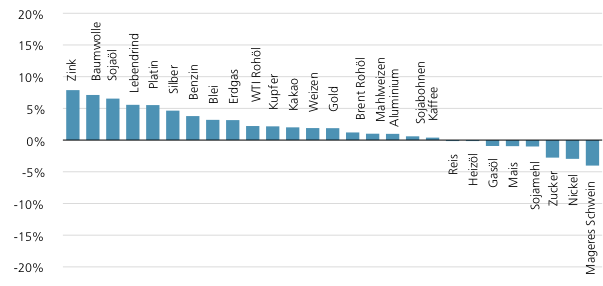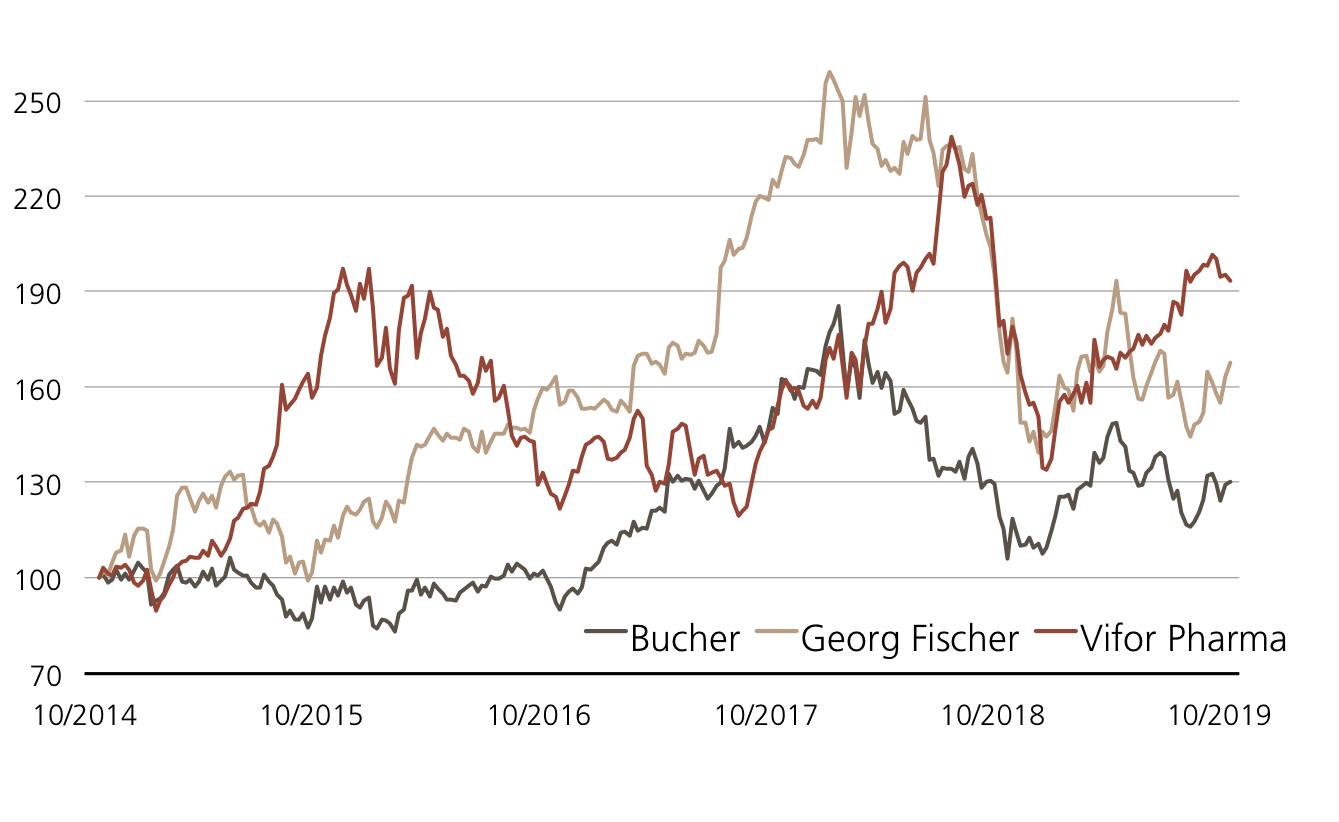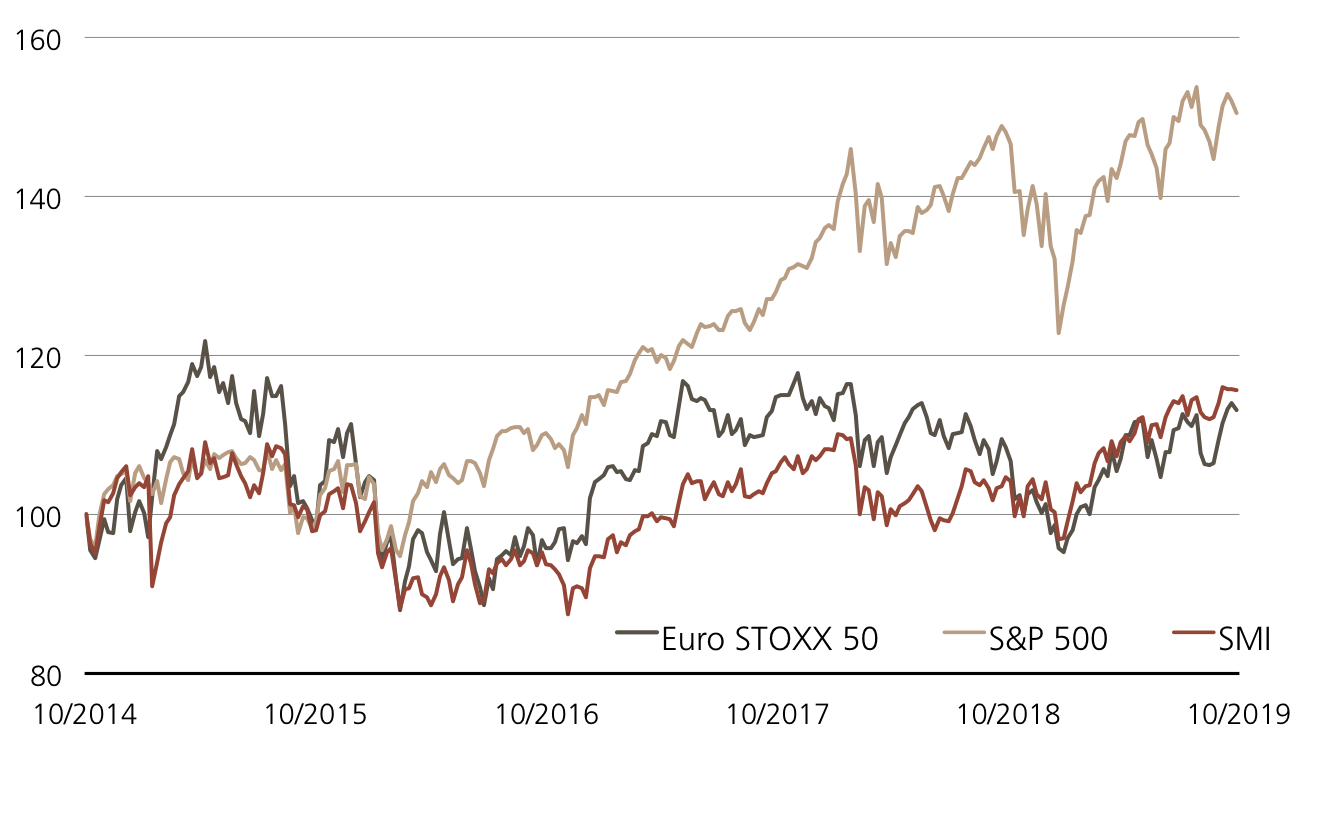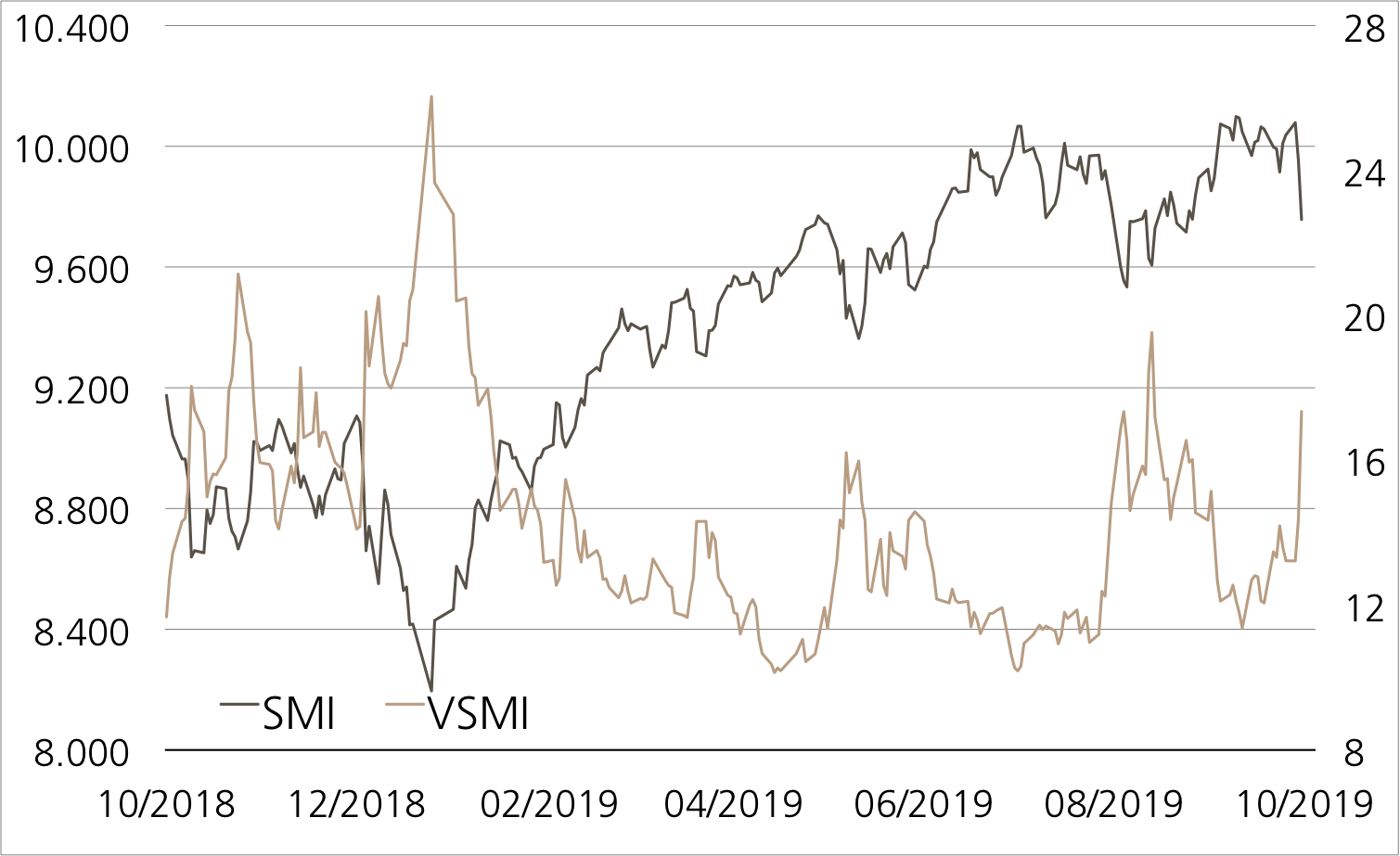Weekly-Hits: Europäischer Chemiesektor & Facebook

- Thema 1: Europäischer Chemiesektor – Der Blick geht nach vorne
- Thema 2: Facebook – Die Community wächst
Europäischer Chemiesektor
Der Blick geht nach vorne
Seien es Medikamente, Elektronikgeräte, Baustoffe oder Autos: Die Erzeugnisse des Chemiesektors kommen in vielen Wirtschaftsgütern zum Einsatz. Entsprechend abhängig ist diese Branche vom konjunkturellen Auf und Ab. Bekanntlich haben insbesondere der Handelsstreit zwischen den USA und China sowie die ungelöste Brexit-Frage die Weltwirtschaft ausgebremst. «Im bisherigen Jahresverlauf mussten – mit Ausnahme der Bauindustrie – fast alle Kundenindustrien ihre Produktion drosseln», stellt Henrik Meincke, Chefvolkswirt beim deutschen Verband der Chemischen Industrie (VCI) fest. (Quelle: VCI, «Chemiekonjunktur – Licht und Schatten in den Abnehmerbranchen der Chemie», 20.10.2019)
In der jüngsten Berichtssaison hat sich diese Einschätzung bestätigt. Beispiel BASF: Für 2019 rechnet das europäische Branchenschwergewicht mit einem leichten Umsatzrückgang. Gleichzeitig soll der bereinigte operative Gewinn um bis zu 30 Prozent einbrechen. Während BASF die Prognose bereits im Sommer nach unten angepasst hatte, konnte der Konzern mit den Zahlen für das dritte Quartal positiv überraschen. Der Profit gab von Juli bis September weniger stark nach, als von Analysten durchschnittlich erwartet. Neben einer starken Nachfrage nach Katalysatoren in China und Indien half dem Unternehmen die Erholung des Agrargeschäfts. (Quelle: Thomson Reuters, Medienbericht, 24.10.2019)
Licht und Schatten enthielt der Zwischenbericht von Clariant. Zwar verfehlte der Spezialchemiehersteller im dritten Quartal mit Umsatz und Ergebnis die Erwartungen. Doch stellte CFO Patrick Jany für das kommende Jahr eine Stabilisierung des Geschäfts in Aussicht. Gleichzeitig hält Clariant an der Zielsetzung für 2021 fest. Die Basler möchten überdurchschnittlich wachsen, die Profitabilität steigern und ihre Cashflow-Generierung stärken. (Quelle: Thomson Reuters, Medienbericht, 30.10.2019) Auch bei Givaudan hat die mittelfristige Zielsetzung Bestand. Generell zeigt sich der Aromen- und Dufthersteller relativ immun gegen das schwierige Umfeld. In den ersten neuen Monaten 2019 verbuchte Givaudan auf vergleichbarer Basis ein Umsatzwachstum von 6.4 Prozent auf knapp 4.7 Milliarden Franken. (Quelle: Thomson Reuters, Medienbericht, 10.10.2019)
Chancen: Der STOXX™ Europe 600 Chemicals Net Return Index deckt diesen spannenden Sektor in seiner gesamten Breite ab. Eine Order reicht, um den diversifizierten Benchmark – die 24 Mitglieder kommen aus acht verschiedenen Ländern – mit einem ETT (Symbol: ETCHM) in das Portfolio aufzunehmen. Für Anleger mit einem eher skeptischen konjunkturellen Szenario bietet sich der Callable Kick-In GOAL (Symbol: KEPXDU) als Alternative an. Die Basiswerte BASF, Clariant, EMS-Chemie und Givaudan machen eine Couponzahlung von 8.25 Prozent p.a. möglich. In die Laufzeit geht das prominente Chemie-Quartett mit einem Barriereabstand von jeweils 40 Prozent. Die Emittent hat das Recht, den Kick-In GOAL vorzeitig zu kündigen und zurückzuzahlen.
Risiken:Die vorgestellten Produkte sind nicht kapitalgeschützt. Eine negative Entwicklung des Basiswerts führt beim ETT zu entsprechenden Verlusten. Notiert einer der Basiswerte beim Kick-In GOAL während der Laufzeit einmal auf oder unter dem jeweiligen Kick-In Level (Barriere) und kommt zudem das Callable Feature nicht zum Tragen, kann die Rückzahlung am Verfalltag durch Bartilgung entsprechend der (vom Strike aus) schwächsten Performance aus dem Quartett erfolgen (höchstens jedoch zum Nominalwert zuzüglich Coupon). In diesem Fall sind Verluste wahrscheinlich. Zudem trägt der Anleger bei Strukturierten Produkten das Emittentenrisiko, so dass das eingesetzte Kapital – unabhängig von der Entwicklung der Basiswerte – im Falle einer Insolvenz der UBS AG verloren gehen kann.

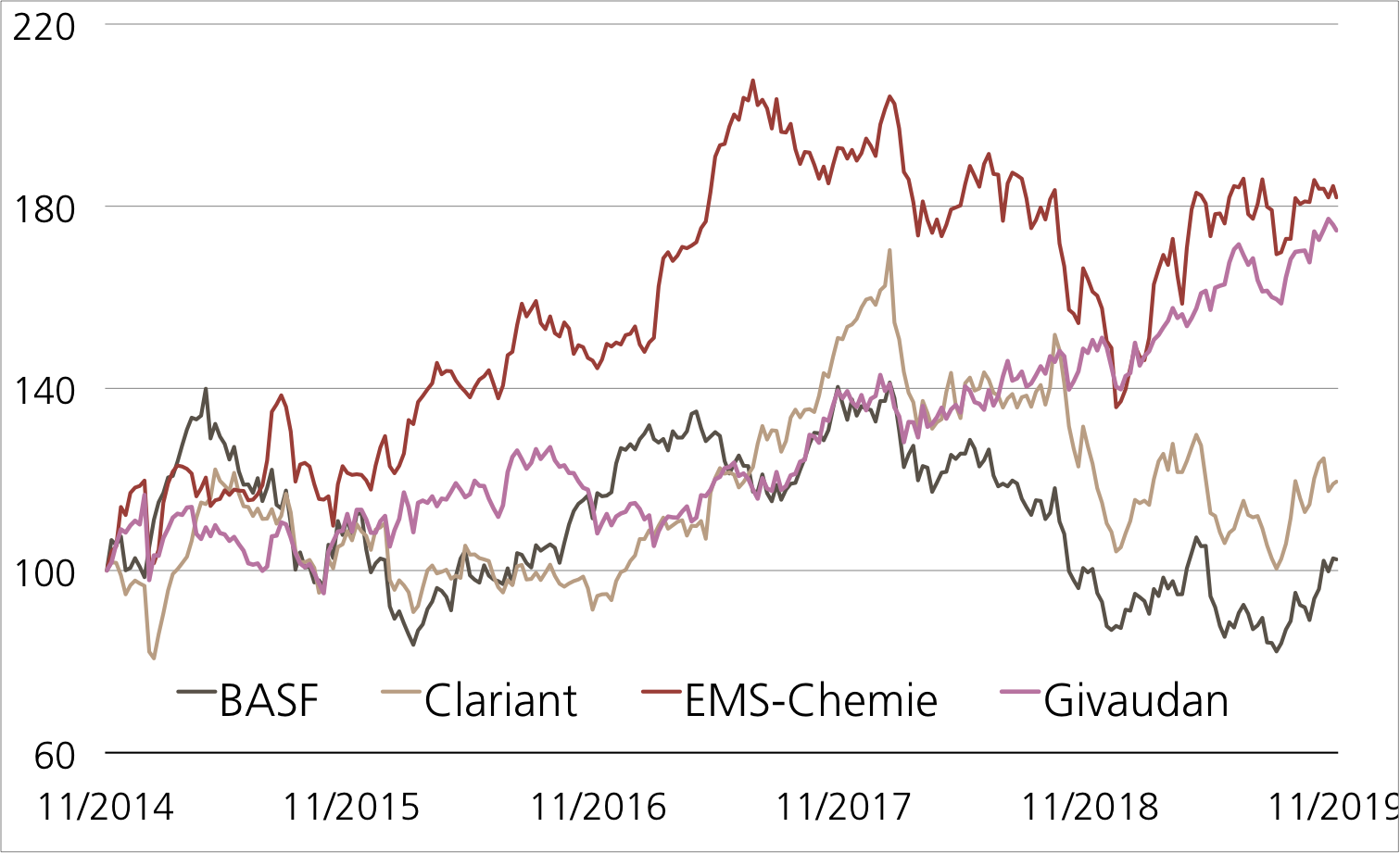
²) Die Konditionen der ETTs werden jährlich überprüft und können mit einer Frist von 13 Monaten nach Bekanntgabe angepasst werden.
| Index | Stand | Woche¹ | |
|---|---|---|---|
| SMI™ | 10’299.22 Pkt. | -0.2% | |
| SLI™ | 1’581.86 Pkt. | -0.4% | |
| S&P 500™ | 3’094.04 Pkt. | 0.6% | |
| EURO STOXX 50™ | 3’699.50 Pkt. | 0.3% | |
| S&P™ BRIC 40 | 4’290.89 Pkt. | -2.4% | |
| CMCI™ Compos. | 902.99 Pkt. | -0.4% | |
| Gold (Feinunze) | 1’463.30 USD | -2.0% | |

Facebook
Die Community wächst
Gleichzeitig muss Facebook jedoch tief in die Tasche greifen, um die unterschiedlichen Problemfelder zu lösen respektive den Ansprüchen von Nutzern, Verbraucherschützern und Politik Rechnung zu tragen. Dabei steht der Konzern weiterhin vor beträchtlichen Herausforderungen. In den USA überprüft neben dem Kongress das Justizministerium die Geschäftspraktiken – um nur zwei Beispiele zu nennen. Auf Gegenwind stösst das Unternehmen auch mit der geplanten Digitalwährung Libra. (Quelle: Thomson Reuters, Medienbericht, 30.10.2019)
Chancen:In der Gemengelage aus Wachstumschancen und öffentlicher Kritik kommt die Facebook-Aktie seit rund einem halben Jahr per Saldo nicht mehr voran. Für den ER Kick-In GOAL (Symbol: KEOKDU) wäre die Fortsetzung dieses Preistrends geradezu optimal. Selbst ein moderater Kursrückgang könnte die Renditechance von 8.25 Prozent p.a. nicht in Gefahr bringen. In die Laufzeit von 18 Monaten startet Facebook mit einem Barriereabstand von 35 Prozent. Erstmals am 19. Mai 2020 und dann alle drei Monate kommt der Basiswert auf den Prüfstand. Notiert die Aktie an einem der Beobachtungstage auf oder über ihrem Startniveau, greift die Early Redemption Funktion. Anleger erhalten dann sowohl das vollständige Nominal als auch den anteiligen Coupon vorzeitig zurückbezahlt.
Risiken:Kick-In GOALs sind nicht kapitalgeschützt. Notiert Facebook während der Laufzeit einmal auf oder unter dem Kick-In Level und kommt zudem das Early Redemption Feature nicht zum tragen, kann die Tilgung am Verfalltag durch Bartilgung erfolgen (höchstens jedoch zum Nominalwert zuzüglich Coupon). In diesem Fall sind Verluste wahrscheinlich. Zudem trägt der Anleger bei Strukturierten Produkten das Emittentenrisiko, so dass das eingesetzte Kapital – unabhängig von der Entwicklung des Basiswertes – im Falle einer Insolvenz der UBS AG verloren gehen kann.

8.25% p.a. Early Redemption Kick-In GOAL auf Facebook
| Remove | ||
|---|---|---|
| Symbol | KEOKDU | |
| SVSP Name | Barrier Reverse Convertible | |
| SVSP Code | 1230 (Auto-Callable) | |
| Basiswert | ||
| Handelswährung | USD | |
| Coupon | 8.25% p.a. | |
| Kick-In Level (Barriere) | 65% | |
| Verfall | 20.05.2021 | |
| Emittentin | UBS AG, London | |
| Zeichnung bis | 20.11.2019, 15:00 Uhr | |
Termsheet Weitere Produkte sowie Informationen zu Chancen und Risiken finden Sie unter: ubs.com/keyinvest Quelle: UBS AG Stand: 13.11.2019
²) Die Konditionen der ETTs werden jährlich überprüft und können mit einer Frist von 13 Monaten nach Bekanntgabe angepasst werden.







